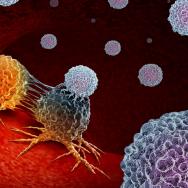Multiple sclerosis, an autoimmune disease of the central nervous system that affects millions worldwide, can cause debilitating symptoms for those who suffer from it.
Though treatments exist, researchers are still searching for therapies that could more effectively treat the disease, or even prevent it altogether.
Researchers at the Pritzker School of Molecular Engineering (PME) at the University of Chicago have designed a new therapy for multiple sclerosis (MS) by fusing a cytokine to a blood protein. In mice, this combination prevented destructive immune cells from infiltrating the central nervous system and decreased the number of cells that play a role in MS development, leading to fewer symptoms and even disease prevention.
Their results, published Oct. 12 in the journal Nature Biomedical Engineering, could eventually lead to a new therapy for the disease.
“The exciting result is that we can suppress MS symptoms in a way that is more effective than current treatments,” said Jeffrey Hubbell, Eugene Bell Professor in Tissue Engineering and co-author of the paper.
Binding therapy to a blood protein
While most immune cells help protect the body from disease, in patients with MS, autoreactive immune cells infiltrate the central nervous system and cause damage. Recent studies have shown that Th17 cells, immune cells that are activated in the body’s secondary lymphoid organs, migrate to the brain and play a role in the severity of the disease. Several drugs to treat MS work by sequestering these cells in the lymph nodes and preventing them from targeting tissue, but these drugs can have adverse side effects.
Interleukin-4 (IL-4), an anti-inflammatory cytokine, is known to suppress the genes that cause MS and has been found to suppress the reactivation of Th17 cells. To use it as a potential therapy, researchers needed to find a way to keep the IL-4 in the secondary lymphoid organs to ensure that Th17 cells were suppressed and did not migrate.
To do this, they bound IL-4 to a blood protein and injected it into mice that had experimental autoimmune encephalomyelitis (the mouse model of MS) and found that it caused the IL-4 to stay within the secondary lymphoid organs. The result was reduced infiltration of Th17 cells into the spinal cord. That suppressed the disease and resulted in fewer symptoms.
A potential new way to prevent MS
Researchers also found that the therapy even prevented MS from developing in the majority of mice they treated with it.
“This is the first time anyone has shown how the fusion of this protein to immunosuppressive cytokines can treat and prevent multiple sclerosis,” said Jun Ishihara, a former postdoctoral researcher in Hubbell’s group and co-corresponding author of the paper.
Though the therapy showed few negative side effects, the researchers will next formally study the toxicity of the therapy in hopes of eventually moving it to human clinical trials.
“This treatment could potentially be self-administered by MS patients at home with an injector pen,” Hubbell said. “We think this is imminently translatable and could lead to better quality of life, with fewer symptoms, for those with the disease.”
Other authors on the paper include Prof. Melody A. Swartz, Ako Ishihara, Elyse A. Watkins, Andrew C. Tremain, Mindy Nguyen, Kiyomitsu Katsumata, Aslan Mansurov, Erica Budina, Aaron T. Alpar, Peyman Hosseinchi, Lea Maillat, Joseph W. Reda, Ani Solanki, Takahiro Kageyama, and Eiji Yuba, all of the University of Chicago.
Citation: “Prolonged residence of an albumin–IL-4 fusion protein in secondary lymphoid organs ameliorates experimental autoimmune encephalomyelitis,” Ishihara et al, Nature Biomedical Engineering, Oct. 12, 2020. DOI: 10.1038/s41551-020-00627-3
Funding: University of Chicago
—This story was first published by the Pritzker School of Molecular Engineering.

